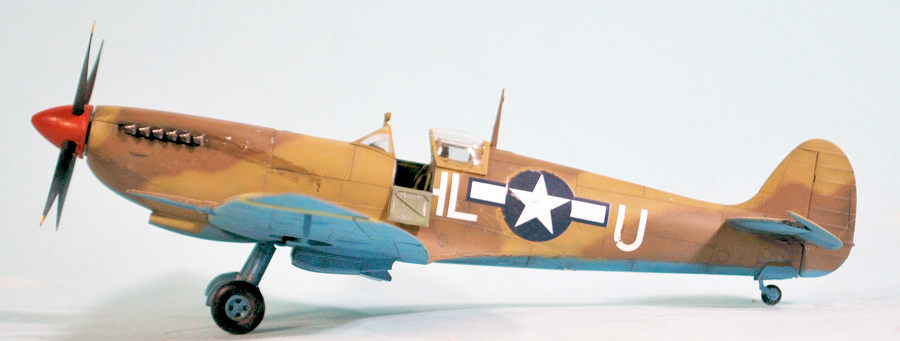
Eduard 1/48 Spitfire HFVIII
| KIT #: | 8287 |
| PRICE: | $49.95 |
| DECALS: | Five options |
| REVIEWER: | Tom Cleaver |
| NOTES: |

| HISTORY |
While the Spitfire IX was both better-known and produced in far larger numbers, the Spitfire VIII represents the high-point of development of the Merlin-powered Spitfire variants.
Basically an unpressurized Mk.VII, the Spitfire VIII had all the
refinements of the first major redesign of the Spitfire since the Mk.I - the
Spitfire V was an “interim” development of a beefed-up Mk.I to take a more
powerful engine, while the Spitfire IX was an “interim” development of the
Mk.V, again to take a more powerful engine. The Mk.VIII had a strengthened
fuselage, reduced-span ailerons, enlarged rudder, increased armor
protection, a retractable tailwheel, and additional fuel in two 14-gallon
tanks in the wing l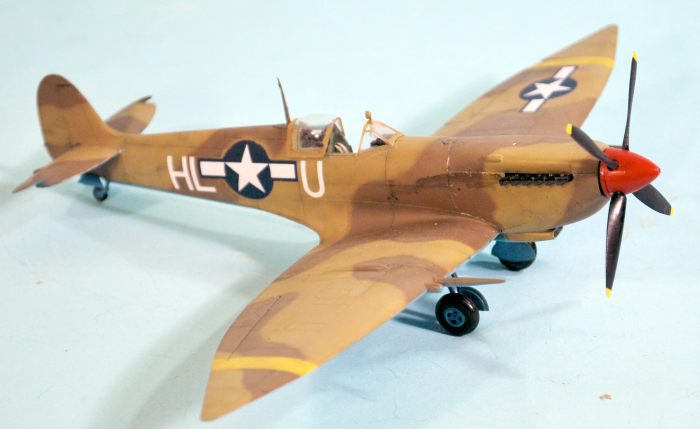 eading edge, in addition to the Merlin 60-series engine
with two-speed supercharger, with all aircraft equipped with the Aero-Vee
filter.
eading edge, in addition to the Merlin 60-series engine
with two-speed supercharger, with all aircraft equipped with the Aero-Vee
filter.
Production of the Spitfure VIII commenced in late 1942, with all aircraft shipped overseas. Initial deliveries were to units in the Mediterranean. Seven Spitfire VIIIs were issued to the 31st Fighter Group in Italy in October 1943, serving until the unit converted to the P-51 in March 1944 and was assigned to the 15th Air Force.
Some early production models had extended wingtips but the majority were fitted with the standard version; according to Supermarine's Chief Test pilot Jeffrey Quill "When I am asked which mark of Spitfire I consider the best from the flying point of view, I usually reply 'The Mark VIII with standard wingtips.' I hated the extended wingtips...They were of no practical value to the Mark VIII and simply reduced the aileron response and the rate of roll." These Spitfires, known as the Spitfire HF Mk. VIII, were powered with a high-altitude rated Merlin 790 engine.
Yankee Spitfires:
The 31st Pursuit Group was created in January 1941 at Selfridge Field, Michigan, with cadre personnel from the 1st Pursuit Group. That spring, the unit was the first to equip with the new Bell P-39 Airacobra when it entered production. The three squadrons operated their P-39s with the “Red Forces” during the Louisiana War Games that fall, which was dress rehearsal for the U.S. armed forces for World War II.
Following Pearl Harbor, the 31st was sent to the west coast to provide air defense. At the beginning of January, 1942, personnel from the 1st and 31st groups formed the 52nd Pursuit Group, and at the end of the month the 31st’s 39th, 40th and 41st Pursuit Squadrons were transferred to the 35th Pursuit Group, and sent to Australia. The 31st was reorganized with the 307th, 308th and 309th squadrons and sent to Paine Field Washington, where they operated P-40s until May when they once again received P-39s. Now the 31st Fighter Group after the May 5, 1942 reorganization, the group was alerted for transfer to Europe at the end of the month.
Initially, it was planned to fly the P-39s trans-Atlantic to the UK,
via Labrador, Greenland, Iceland and northern Scotland, with the airplanes
toting a 175 gallon ferry tank. Tests showed the P-39 could barely get
airborne from a long paved runway with a full tank, and once in the air was
highly unstable, with the instability inc reasing as fuel was drained from
the tank and began sloshing inside due to a lack of baffles. Two P-39s were
lost in these tests and it was decided the group and its airplanes would
travel by ship. The ground echelon went to England aboard the Queen Mary and
got arrived in Liverpool on June 7. The pilots arrived two weeks later,
traveling by Army transport. When they got to their new base at Atcham, they
found they had a new airplane, the Spitfire Vb, courtesy of the RAF via
Reverse Lend-Lease, the RAF having convinced VIII Fighter Command that the
P-39 was hopeless in the ETO from their experience with the export Airacobra
I.
reasing as fuel was drained from
the tank and began sloshing inside due to a lack of baffles. Two P-39s were
lost in these tests and it was decided the group and its airplanes would
travel by ship. The ground echelon went to England aboard the Queen Mary and
got arrived in Liverpool on June 7. The pilots arrived two weeks later,
traveling by Army transport. When they got to their new base at Atcham, they
found they had a new airplane, the Spitfire Vb, courtesy of the RAF via
Reverse Lend-Lease, the RAF having convinced VIII Fighter Command that the
P-39 was hopeless in the ETO from their experience with the export Airacobra
I.
After training, the unit was declared operational in August, with the three squadrons operating individually with three different RAF Spitfire wings in 11 Group to gain experience. They flew their first mission as a group in the Dieppe Raid on August 19, during which they scored the first USAAF victories against the Luftwaffe: two Fw 190s shot down, four damaged, a Do-217E damaged, and three Fw 190s probable. For this they lost one pilot dead, three wounded, and seven airplanes shot down or heavily damaged.
After further missions over northern France providing escort to the B-17s of VIII Fighter Command on their early missions, the group was transferred along with the 52nd which also had Spitfires, and the 1st, 14th and 82nd groups with P-38s to the XII Air Force for the invasion of North Africa.
The US fighter units faced a steep learning curve in North Africa when the Luftwaffe transferred three experienced Jagdgeschwaders to the theater following the invasion. At first there were more losses than victories, but by the Battle of Kasserine Pass in February 1943, the 31st had found their feet and were able to hold their own, even after the Luftwaffe had sent the Fw 190s of II/JG 2 to Tunisia. In answer to the appearance of the Fw 190s, the group began receiving limited numbers of Spitfire IXs beginning in March 1943. These were distributed in 4-plane packets to each of the squadrons, where they formed a high-altitude cover flight for the rest of the squadron, flown by the best pilots in each unit.
Following the German surrender in North Africa in May 1943, the 31st
received more Spitfire Ixs, in time for the air battles over Sicily and then
over southern Italy following the invasion that September. In October 1943,
the 308th Squadron received seven Spitfire VIIIs, including two early HF
models, distinguishable from the o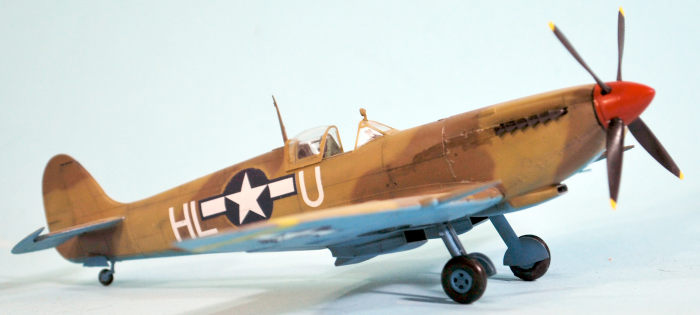 thers by having the original Spitfire
rudder, and wings with extended tips. In December, five more Spitfire VIIIs
arrived. All these Merlin-60 Spitfires saw combat against the Luftwaffe
during the battles in Southern Italy, most particularly the battles over
Monte Cassino and Anzio.
thers by having the original Spitfire
rudder, and wings with extended tips. In December, five more Spitfire VIIIs
arrived. All these Merlin-60 Spitfires saw combat against the Luftwaffe
during the battles in Southern Italy, most particularly the battles over
Monte Cassino and Anzio.
In late February, the 31st was transferred to Corsica with the 52nd, which was still only equipped with Spitfire Vb’s. In March, the two units joined the P-47-equipped 325th Fighter Group in the Fifteenth Air Force, and all three were re-equipped with the P-51 Mustang to participate as bomber escorts in the campaign against Ploesti that began in April.
The Spitfires had provided the XII Air Force with a badly-needed tactical air superiority fighter that could successfully take on the Luftwaffe over the battlefield in North Africa and then in Sicily and Italy until the Luftwaffe withdrew from Italy after the fall of Cassino.
| THE KIT |
Eduard released the Spitfire VIII in 2015, and followed up in 2019 with this re-release as an HF Mk. VIII. Outside of the decals, this kit is the same as the previous release, other than all the five options are “long wing” Spitfires with the extended wingtip.
The kit contains markings for HF Mk. VIIIs of 32 Squadron in the Medium Sea Grey/PRU blue scheme, a 1 Squadron SAAF airplane in standard Ocean Grey/Dark Green/Medium Sea Grey camouflage, two in desert camo from 92 Squadron RAF and the 31st’s 308th FS, and a SEAC Spitfire VIII from 81 Squadron, also in the original desert camouflage.
| CONSTRUCTION |
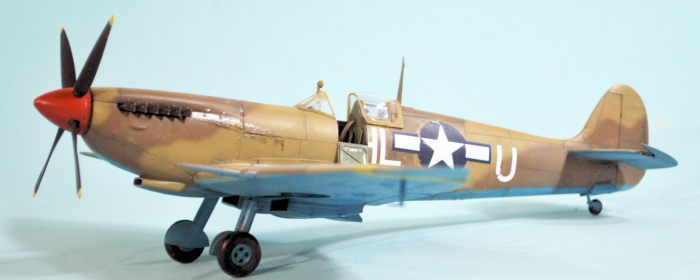 As with the rest of the Eduard Spitfires, be absolutely certain that you
trim off all sprue connections, because fit is tight and precise, and any
residue will adversely affect the way things go together.
As with the rest of the Eduard Spitfires, be absolutely certain that you
trim off all sprue connections, because fit is tight and precise, and any
residue will adversely affect the way things go together.
If you have built one of these Eduard Spitfires before, there are no surprises here. I painted and assembled the cockpit, then the fuselage, then the wing sub-assembly, then brought the two major sub-assemblies together, then attached the horizontal stabilizer, elevators and rudder.
If you work carefully, you will not need putty or filler anywhere. If you assemble the two parts of the upper engine cowling as a separate sub-assembly and press them together tightly enough to get glue to rise from the joint, you can scrape that smooth and avoid having to get a resin replacement cowling.
| COLORS & MARKINGS |
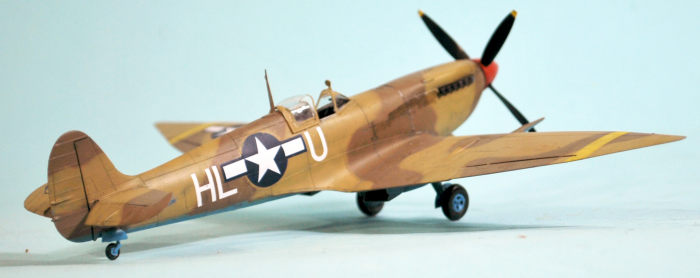 I did a sun-faded scheme with Tamiya mistures for Dark Earth, Middle
Stone and Azure Blue. I then placed some cutout masks the size of the RAF
national insignia in position on the upper wing and fuselage, and painted the
circle with “fresh” Middle Stone as those markings were overpainted. The “wrapround”
upper camouflage on the lower nose marks this as one of the Spitfire VIIIs
repainted from the RAF standard scheme at the Aboukir, Egypt assembly depot.
I did a sun-faded scheme with Tamiya mistures for Dark Earth, Middle
Stone and Azure Blue. I then placed some cutout masks the size of the RAF
national insignia in position on the upper wing and fuselage, and painted the
circle with “fresh” Middle Stone as those markings were overpainted. The “wrapround”
upper camouflage on the lower nose marks this as one of the Spitfire VIIIs
repainted from the RAF standard scheme at the Aboukir, Egypt assembly depot.
Knowing this airplane had been modified for the desert at Aboukir meant I didn’t have to worry about the usual Spitfire stencils, since all that was overpainted and not re-marked afterwards. Thus all I had to worry about was the National markings and squadron ID markings.
I gave the model a couple overall coats of Clear Flat, then “dinged” the airplane with a silver Prismacolor pencil, then did exhaust and oil stains with Tamiya “Smoke.” I then attached the landing gear, unmasked the canopy and installed it in the open position, and attached the propeller.
| CONCLUSIONS |
Eduard really “owns” the Merlin-60 Spitfires. The result if you are careful in assembly is a “definitive” Spitfire model. The markings options in the kit will give a distinctive-looking result, whichever one you choose. Highly recommended for all “Spit boffins.”
Tom Cleaver
2 September 2021 Copyright ModelingMadness.com. All rights reserved. No
reproduction in part or in whole without express permission.
Review kit courtesy of Eduard. If you would like your product reviewed fairly and fairly quickly, please contact the editor or see other details in the
Note to
Contributors. Back to the Main Page
Back to the Review
Index Page
Back to the Previews Index Page